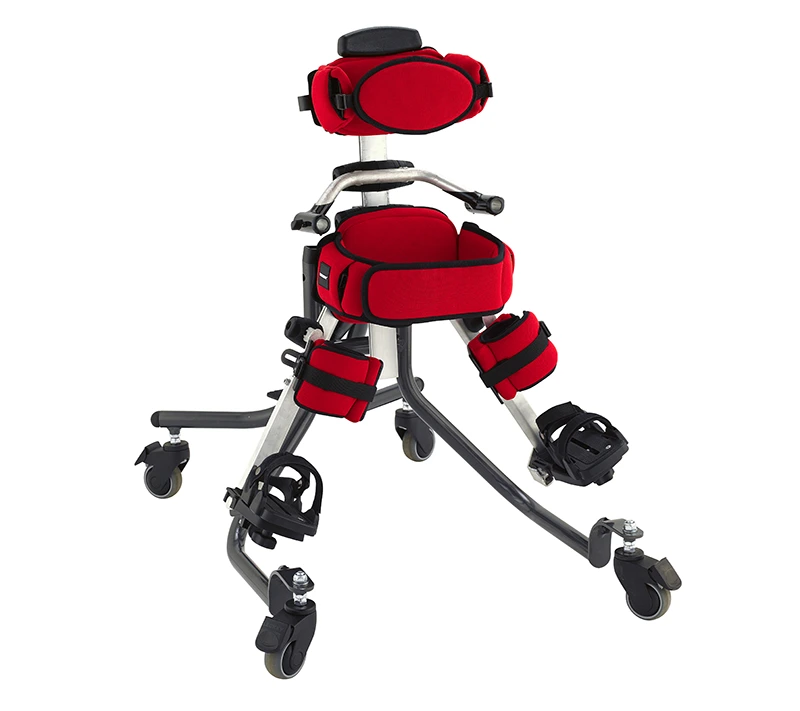Take it offline!
This Education in Motion resource is also available as a printable PDF.
Download PDF
Standing therapy is an essential part of 24-hour postural management and confers a range of benefits to children, including: increase in bone mineral density, improvement in range of movement, aiding bladder & bowel function, and aiding formation of the hip joint. The associated psychological benefits of being upright with peers aids communication and improves general wellbeing. The Leckey Squiggles+ Stander is a versatile 3-in-1 standing frame which can be positioned prone, supine, and upright. It has individually adjustable leg supports which support an abducted standing program or accommodate leg length difference, giving a safe and comfortable position for the child.
Benefits of standing frames
The benefits of standing upright are well established and include an increase in bone mineral density, decrease in spasticity, improved range of movement, improved bladder & bowel function, improved cardiorespiratory and cardiopulmonary function, and increased pressure relief (Glickman, 2010).
In addition to the numerous physical benefits of standing, there is an abundance of psychological, social, and emotional benefits to being in a standing frame such as improved confidence, self-esteem, and self-image; increased alertness and improved cognitive function; and it encourages interaction at eye level with peers (Paleg et al, 2013; Taylor, 2009; Lind, 2003; Goodwin et al, 2018).
Children with disabilities are more likely to lead excessively sedentary lives, with the greater the motor impairment the more inactive their everyday life (Verschuren, 2016). Studies (Ainsworth et al, 2011) have reported that energy metabolism is doubled merely by standing instead of sitting, which is highly relevant to children who spend many hours a day sitting in a wheelchair or specialist seat.
Studies have shown that standing with hips in abduction may also improve hip migration percentage and maintain hip muscle length and therefore reduce the risk of hip displacement in children with cerebral palsy (Martinsson and Himmelmann, 2021; Macias-Merlo et al, 2015).

Potential clinical rationale for selection of Squiggles+
3-in-1 frame
The Squiggles+ enables children to be supported a prone, upright, or supine position whilst maintaining good postural alignment. The individual footplates are able to accommodate children who have a leg length discrepancy.
Improved comfort and positioning
The padded supports will ensure comfort whilst the child is in the frame. The medial knee supports distribute pressure, especially suited to abducted standing, whilst maintaining the child's knees in neutral alignment. The knee supports can be rotated to provide extra lateral support for children with low tone.
Achieve anatomically correct hip abduction
The Squiggles+ standing frame enables the child to achieve hip abduction of up to 60° in prone, upright, and supine standing. It has a measurement gauge to monitor and aid repeatability. The frame design promotes correct alignment of the hips, knees, and feet as the abduction pivot points are in line with the hip joint center. The hip laterals also shift in sync with the legs as they move through the arc of abduction to prevent discomfort.
Safe and easy transfers
When transferring children who have more complex needs and are using the standing frame in a supine configuration, the larger hip pads improve the carer and child's confidence and feeling of security during the transfer. The chassis pivot has also been improved to facilitate full horizontal loading.
References
- Glickman, L. B., Geigle, P. R., & Paleg, G. S. (2010). A systematic review of supported standing programs. Journal of pediatric rehabilitation medicine, 3(3), 197-213.
- Paleg, G. S., Smith, B. A., & Glickman, L. B. (2013). Systematic review and evidence-based clinical recommendations for dosing of pediatric supported standing programs. Pediatric Physical Therapy, 25(3), 232-247.
- Taylor, K. (2009). Factors affecting prescription and implementation of standing-frame programs by school-based physical therapists for children with impaired mobility. Pediatric Physical Therapy, 21(3), 282-288.
- Lind, L. (2003). 'The pieces fall into place': the views of three Swedish habilitation teams on conductive education and support of disabled children. International journal of rehabilitation research, 26(1), 11-20.
- Goodwin, J., Colver, A., Basu, A., Crombie, S., Howel, D., Parr, J. R., ... & Cadwgan, J. (2018). Understanding frames: A UK survey of parents and professionals regarding the use of standing frames for children with cerebral palsy. Child: care, health and development, 44(2), 195-202.
- Ainsworth, B. E., Haskell, W. L., Herrmann, S. D., Meckes, N., Bassett, D. R., Tudor-Locke, C., ... & Leon, A. S. (2011). 2011 Compendium of Physical Activities: a second update of codes and MET values. Med Sci Sports Exerc, 43(8), 1575-1581.
- Verschuren, O., Peterson, M. D., Leferink, S., & Darrah, J. (2014). Muscle activation and energy-requirements for varying postures in children and adolescents with cerebral palsy. The Journal of pediatrics, 165(5), 1011-1016.
- Martinsson, C., & Himmelmann, K. (2021). Abducted standing in children with cerebral palsy: effects on hip development after 7 years. Pediatric Physical Therapy, 33(2), 101-107.
- Macias-Merlo, L., Bagur-Calafat, C., Girabent-Farrés, M., & Stuberg, W. A. (2015). Standing programs to promote hip flexibility in children with spastic diplegic cerebral palsy. Pediatric Physical Therapy, 27(3), 243-249.